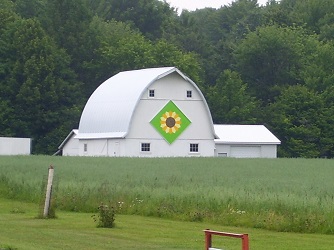By JULIANA MOXLEY
Capital News Service
LANSING – Preserved barns help people remember rural history, save money and boost tourism revenue.
They represent our heritage and hold a special place in our collective rural memory, said Steve Stier, former president of the Michigan Barn Preservation Network.

A sunflower quilt block at White Barn Gardens near Harrisville. Credit: Cindi Van Hurk.
Tearing down old barns or replacing them with new pole barns isn’t always wise, Stier said. Disposing of an old barn can cost several thousand dollars.
“I tell folks that usually a barn can be repaired for about as much as it would be to dispose of it properly,” Stier said.
The Michigan Barn Preservation Network will hold its annual conference March 14 at Michigan State University.
Traditionally barns were used for storage and shelter, but they are adaptable, Stier said. Old barns have been used as churches, restaurants, furniture stores, wineries and event spaces, and their use is limited only by the imagination and resources of their owners.
And their preservation can boost a community’s economy, depending on the barn’s use and the surrounding landscape.
Old barns are increasingly part of quilt trails, with painted wooden squares displayed on a series of barns as a tourist attraction. Many barn quilt trails in Michigan attract tourists who spend money on gas, food and lodging, Stier said.
For example, Alcona County residents formed a committee in 2007 for the Alcona County Quilt Trail Project. It uses old barns to attract tourists and boost the economy, said Cindi Van Hurk, president of the project.
Quilt trails are growing in popularity, Van Hurk said. The committee knows of 13 in Michigan, and there may be more.
Among them are trails on the Old Mission Peninsula, the Keweenaw Peninsula and Mecosta and Wexford/Missaukee counties.
The one in Alcona County is the first in Michigan to offer a trail through barns and other property showcasing hand-painted quilt blocks, Van Hurk said. The quilt squares represent either the properties’ history or their owners’ family heritage.
The quilt blocks along the Alcona County Quilt Trail are hand-painted designs on wood hung on 28 barns and other buildings.
The trail came at a critical time, Van Hurk said. A former county treasurer had embezzled funds, shocking and embarrassing residents. The committee wanted a project that would involve the community and saw the project as a healing experience.
A six-person local committee collaborated with a Michigan State University class that researched how other states had done quilt trails, what materials were needed for the project and how the committee would construct the quilt blocks.
The committee installed the first quilt block in the spring of 2008.
“One of our goals was to have equal representation throughout the county, so we set a goal of two quilt squares for each of our 11 townships, with plans for a five-year life of the project,” Van Hurk said.
The committee produced 28 squares by 2009, Van Hurk said. Then it shifted into promoting the trail.
“We have passed the five-year mark and we are still going,” Van Hurk said. “We know that other trails that don’t continue to publicize and actively promote result in dead trails with little impact on the area.”
The trail has been successful, although she said it’s impossible to count the number of people who visit the trail. More than 5,000 paper maps of the trail have been distributed, but that doesn’t count ones that people have printed from the Alcona County Quilt Trail’s website.
The Department of Transportation has requested more brochures for its welcome centers because of the demand, Van Hurk said.
She said it’s important to use every resource available to bring tourism dollars to Alcona County. Aside from the county government, including the sheriff’s department and road commission, and a few small industrial shops, Van Hurk said most residents make their living from family-owned businesses.
“So anything that we can do that brings people into our county is a plus,” Van Hurk said. “Also, the trail is a source of pride for the people here.”
And when Alcona County residents have visitors, they take them on the trail and show them the squares, Van Hurk said.
That’s also true in other Great Lakes states.
For example, LaGrange County in northern Indiana has a barn quilt trail that celebrates the history of agriculture, the time-honored tradition of quilting and the community’s passion for art, community pride and Hoosier hospitality, said Beth Thornburg, executive director of the LaGrange County Convention and Visitors Bureau.
The quilt trail, which opened in 2011, encompasses six communities and 29 stops at quilt patterns that tell stories about family, history and culture.
While the goal is to connect communities and encourage tourists to enjoy the scenic countryside, it’s difficult to measure the economic impact because it’s a free attraction, Thornburg said. Plans include adding more stops along the way, such as ice cream shops and local artisans.
Juliana Moxley writes for Great Lakes Echo.
Extra resources for CNS editors
Alcona County Quilt Trail: http://www.alconaquilttrail.com/
Old Mission Peninsula Quilt Trail: http://www.mibarn.net/Quilt%20Barns.htm
Copper Country Quilt Block Trail: http://www.coppercountryquiltblocktrail.com/
Mecosta County Quilt Trail: http://remus.org/category/mecosta-county-quilt-trail
Interactive quilt trail map: http://barnquiltinfo.com